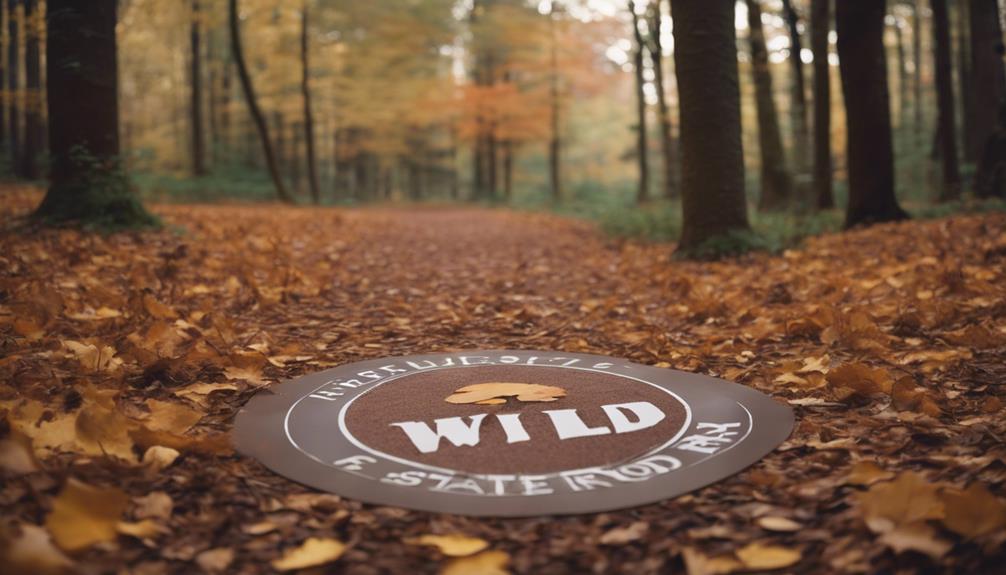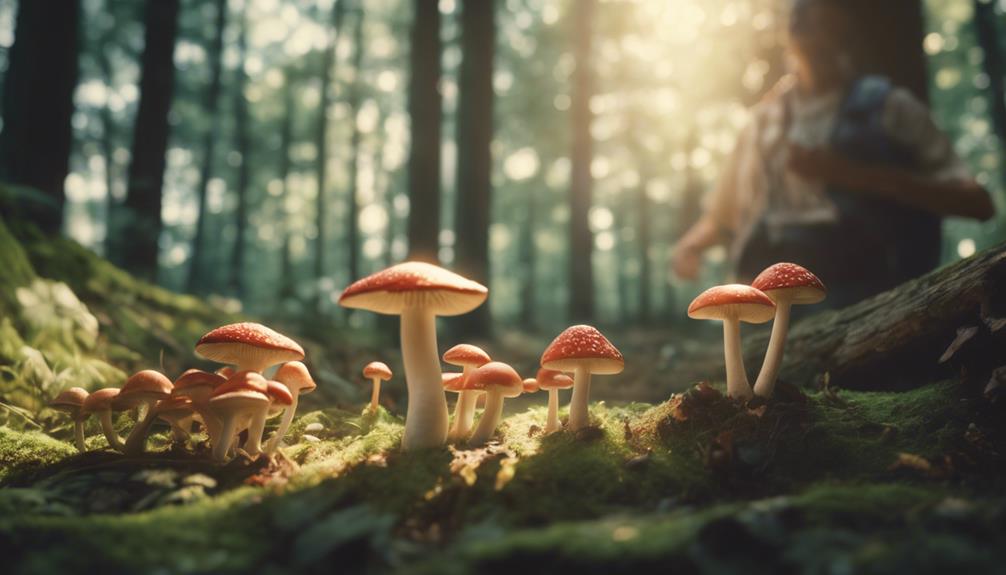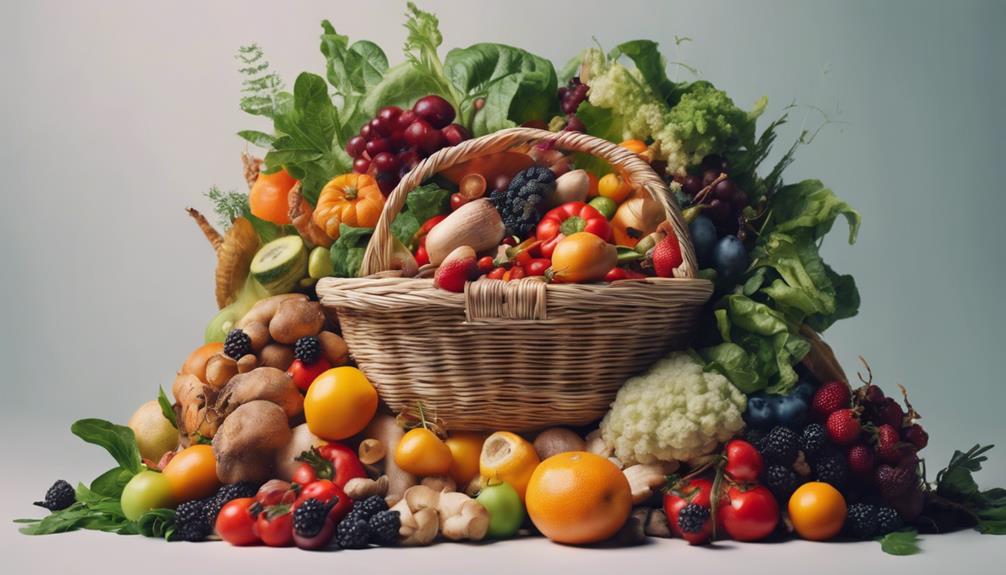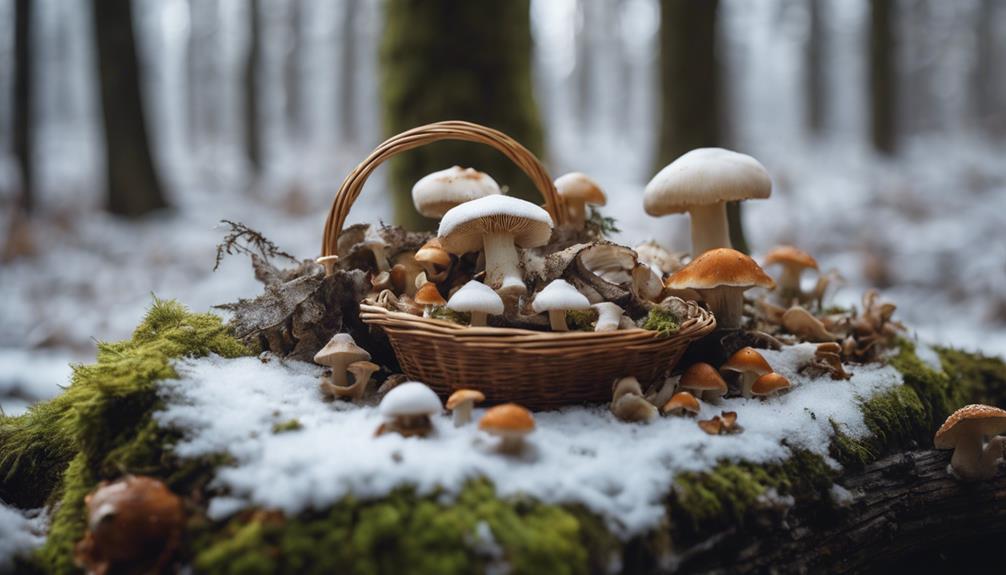Processing and preserving wild foods is an exciting adventure! Start by foraging in the right season to grab fresh greens and berries. You can try methods like canning, freezing, or drying these tasty treats to enjoy later. For instance, blanch your wild veggies before freezing them to keep them bright and yummy. You might also create tangy picks using vinegar brine or make delicious jams with wild fruits. Remember, storing your goodies in cool, dark places keeps them fresh. There's so much more to learn about wild foods and how to make the most of your foraging adventures!
Key Takeaways
- Canning: Sterilize jars and process foods to extend their shelf life for years, ensuring safe storage conditions.
- Pickling: Use vinegar brine to enhance flavors over time; store in cool places for best results.
- Freezing: Blanch wild foods before freezing to maintain flavor, texture, and nutritional value.
- Drying: Air-dry or dehydrate wild foods, storing them in airtight containers for long-lasting snacks.
- Fermenting: Submerge wild edibles in saltwater brine to create tangy preserves that enhance flavor and offer health benefits.
Seasonal Living and Wild Foods

When you explore seasonal living, wild foods can play an essential role in your diet and lifestyle. Imagine wandering outside and finding delicious wild edibles waiting to be picked! Foods like dandelion roots or pine cambium flour not only taste great but also connect you to nature's rhythms. You can harvest wild edibles during their peak seasons, ensuring you get the freshest flavors. Additionally, understanding optimal routes for gathering herbs can help you efficiently find wild edibles.
But what happens when the seasons change? That's where preserving wild comes in! You can use methods like canning, pickling, freezing, or drying to keep those tasty treasures around all year long. This way, you can enjoy your foraged goodies even when winter blankets the ground in snow. It's also worth noting that many wild foods, such as celery juice from the wild variant, are rich in nutrients that can support overall health. For example, during the spring season, you might find wild leeks that can be a flavorful addition to your preserved foods. Additionally, incorporating chia seeds into your diet can enhance your nutrient intake, especially during the colder months.
Plus, foraging can save you money. Instead of buying expensive specialty items at the store, you can find them right in your backyard or nearby woods!
Incorporating preserved wild foods into your meals not only adds exciting flavors but also deepens your connection with the environment. So, get ready to begin a fun adventure, explore your surroundings, and discover the wonderful world of wild foods! You'll create tasty dishes that are both nourishing and exciting! Additionally, understanding seasonal growth patterns can enhance your foraging success and ensure you gather the best wild edibles.
Methods of Preservation

Preserving wild foods opens up a world of possibilities for enjoying nature's bounty year-round. You can easily preserve the harvest of wild edible plants using a few fun methods!
One popular way is canning. You place your prepared wild foods in sterilized jars, seal them with lids, and process them in a water bath or pressure canner. This can keep your food tasty for several years! Additionally, proper canning techniques can significantly reduce the risk of spoilage. Proper canning can also enhance the nutritional value of your preserved foods, similar to how herbal teas retain health benefits when brewed correctly. Furthermore, proper preservation methods like canning not only extend the shelf life of your food but also provide a sense of self-sufficiency, especially during emergencies. Similarly, learning essential survival skills, such as purifying water for safe drinking, ensures that you are well-prepared for unexpected situations. By combining food preservation with other preparedness techniques, you can create a resilient lifestyle that supports both your health and peace of mind.
Another method is pickling, where you pack the wild edibles in jars with a hot brine made of vinegar, water, sugar, and spices. Let those flavors develop for weeks in a cool, dark spot.
Freezing is also a great option! Just blanch your wild foods in boiling water for a short time, then put them in freezer-safe containers. This helps keep their flavor and nutrients intact.
If you like chewy snacks, try drying! You can air-dry, use a dehydrator, or apply low heat, storing your dried plants in airtight containers.
Lastly, fermenting is a unique way to add flavor. Submerge wild foods in a salt and water brine to create delicious, tangy treats. Additionally, incorporating nutritious forage mixes can enhance the preservation process by enriching the flavors of your wild foods.
Enjoy experimenting with these methods to savor your wild foods all year!
Wild Food Recipes

Wild food recipes are a fun way to use seasonal ingredients like wild greens, mushrooms, and berries.
You can create unique dishes, like tasty Milkweed shoot pickles or even Burdock hamburgers, that really show off the flavors of foraged foods. Incorporating seeds, such as chia seeds(4g of protein per 2 tablespoons), can enhance the nutritional value of these dishes. Additionally, using wild ingredients like beet juice(high in nitrates) can provide extra health benefits, enhancing your overall meal experience. Including aloe vera juice(rich in phytonutrients) in your recipes can also boost the health benefits of your wild food dishes. Fresh lemon juice(2-3 days in the fridge) can also be a delightful addition to brighten up flavors.
Plus, learning to preserve these wild treats, such as making jam from wild black cherries, means you can enjoy them all year long! Incorporating wild foods into your diet can also provide health benefits that enhance your overall nutrition.
Seasonal Ingredient Highlights
Spring brings a bounty of seasonal ingredients that can elevate your meals and introduce you to unique flavors. Wild foods like nettles, dandelion greens, and wild garlic are perfect for frittatas, soups, and pesto. Foraging can be a fun adventure, and you'll discover how delicious these seasonal ingredients can be! Additionally, incorporating merchant account credit processing into your food business can enhance customer satisfaction and improve cash flow management. Understanding cookie categories can also help you manage your online presence effectively. To ensure your foraged foods are safe to eat, always be aware of contaminated water sources, which can impact the safety of wild ingredients. Adding chia seeds to your dishes can also boost their nutritional value, providing essential omega-3 fatty acids that support heart health.
Here's a table to help you explore some tasty wild foods:
| Seasonal Ingredient | Recipe Ideas |
|---|---|
| Nettles | Frittatas and soups |
| Dandelion Greens | Salads and sautéed dishes |
| Wild Garlic | Pesto and added to pasta |
| Blackberries | Jams and preserves |
| Elderberries | Syrups and desserts |
| Edible Flowers (Violets) | Salads and as colorful garnishes |
You can also add edible flowers like violets and nasturtiums to your salads for a pop of color and flavor. To keep your wild greens fresh, blanch them before freezing. This helps maintain their bright colors and yummy taste for winter meals. Celebrate the season with your favorite wild foods and enjoy the unique flavors they bring to your table!
Unique Culinary Creations
Exploring the world of culinary creativity with foraged ingredients can lead to exciting and unique dishes.
You can transform wild food into delightful meals that make your taste buds dance! Here are some fun ideas to get you started:
- Milkweed shoot pickles: Add tangy flavors that celebrate the season.
- Wild berry jams and jellies: Use wild black cherries or beach plums to create sweet spreads for toast.
- Wild flower syrups: Craft sweet syrups that can become fizzy sodas or toppings for ice cream.
- Frittatas with wild greens: Toss in poke leaves for a nutritious twist on this breakfast classic, as they are often rich in antioxidants that can enhance your overall well-being. Imagination can also inspire you to experiment with different wild foods and flavors. Additionally, engaging children in hands-on learning through these culinary experiences can foster a love for nature and healthy eating.
- Burdock hamburgers: Show off the tasty potential of wild edibles in savory burgers.
These unique culinary creations not only highlight the beauty of foraged ingredients but also encourage you to explore and enjoy the natural world around you. Additionally, many wild plants are rich in antioxidants, which can combat oxidative stress and enhance your overall well-being.
So grab your basket, head outside, and let your imagination run wild! You'll be surprised at the delicious dishes you can create with nature's bounty.
Happy foraging!
Preservation Techniques Overview
Preserving foraged foods is an essential skill that can greatly extend their shelf life and enhance their flavors. When it comes to wild plants, there are several fun preservation techniques you can try. Each method offers unique tastes and keeps your goodies fresh for longer!
First up, there's canning. You seal your wild edibles in sterilized jars and process them to keep them safe for months. Heat pumps can also help maintain a stable environment for your canned goods, ensuring quality preservation. Additionally, improved indoor air quality can also contribute to the overall freshness of your preserved foods. Using eye patches can help reduce dark circles and puffiness, which is beneficial after a long day of foraging. It's important to consider that the foraging range of pollinators can influence the diversity of wild foods available for preservation.
If you prefer something simpler, drying is another great choice. You can air dry, use a food dehydrator, or apply low heat to remove moisture, so your plants don't spoil.
Freezing is super easy, too! Just blanch the wild foods first to lock in their flavors and nutrients, then pop them into freezer-safe bags or containers.
Pickling is a delightful option if you love tangy flavors. By soaking your wild edibles in a vinegar-based brine, you'll create a tasty treat that gets better over time.
Lastly, fermenting can bring out exciting flavors and probiotics! Additionally, utilizing nutritional counseling during your preservation process can enhance the health benefits of your foraged foods.
With these preservation techniques, you'll enjoy your foraged treasures all year round. So, grab your wild plants and start preserving today!
Medicinal Uses of Wild Plants

Now that you've whipped up some tasty wild food recipes, let's explore the amazing world of medicinal plants!
You can use plants like dandelion and elderberry for their powerful health benefits, and I'll show you how to extract their goodness using fun methods like tinctures and infusions. Additionally, many wild plants possess antibacterial and antiviral properties, making them valuable for supporting immune health. Certain plants, like gorse, also provide essential nectar sources for bees, highlighting the interconnectedness of wild foods and pollinators. Air purifiers can also enhance your environment by improving air quality, which is beneficial when using medicinal plants. Furthermore, incorporating herbs like turmeric's anti-inflammatory properties can enhance the overall health benefits of your wild plant preparations. Moreover, some wild plants can also be used in aromatherapy to promote relaxation and emotional well-being.
Plus, you'll learn how to store your creations so they stay fresh and ready to help you whenever you need them!
Extraction Methods Explained
When it comes to harnessing the medicinal properties of wild plants, understanding various extraction methods is essential.
These methods help you capture the goodness of plants to make your own natural remedies. Here are some fun ways to extract those healing powers:
- Alcohol Extraction: Soak wild plants in high-proof alcohol for several weeks, creating strong tinctures. This method can yield potent solutions, similar to how herbal teas like chamomile are used for their soothing benefits. The use of essential oils derived from wild plants can also enhance the potency of your tinctures. Additionally, proper cage setup is crucial for ensuring the effective extraction of flavors and medicinal properties. Using eco-friendly materials during the extraction process can also contribute to the purity of your remedies.
- Glycerin Extraction: Use vegetable glycerin as a sweet solvent, perfect for those who want alcohol-free options.
- Vinegar Infusions: Submerge plant materials in vinegar for weeks, resulting in tangy herbal vinegars that are tasty and good for you!
- Daily Shaking: Remember to shake your infusions daily to help pull out all the active ingredients from the plants.
- Storage Tips: Keep your herbal creations in dark places to protect them from light, which can make them less effective over time.
Using these extraction methods can turn wild plants into powerful remedies, and incorporating herbal alternatives for botox-like effects can enhance your natural anti-aging regimen.
Common Medicinal Plants
Exploring wild plants opens up a treasure trove of medicinal benefits that can enhance your well-being. By using these plants, you can support your life and health in fun and natural ways. Here are some common medicinal plants you might find useful:
| Plant | Benefits |
|---|---|
| Echinacea | Boosts immune system, helps prevent colds |
| St. John's Wort | Supports mood, great for mood disorders |
| Dandelion | Detoxifies liver, tasty in salads |
| Calendula | Heals wounds, soothes skin with oils |
| Ginger | Eases nausea, helps with digestion |
These wild plants can be made into teas, tinctures, or oils, making them easy to use. For example, you can sip ginger tea to feel better when your tummy's upset! Essential oils for relaxation can also complement the soothing properties of ginger. Additionally, regular consumption of herbal teas can contribute to overall mood stability. Dandelion leaves can add a crunchy kick to your salad. Incorporating these plants can also enhance your overall health due to their antioxidant properties. By embracing these wild plants, you're not just enjoying nature; you're also taking steps to feel your best. Incorporating these plants into your routine can complement aromatherapy practices and enhance your overall emotional well-being. Furthermore, using these plants can align with your vibrational energy to support holistic health. So, why not explore your backyard or a nearby field? You might just find some amazing plants waiting to help you live a healthier life!
Storage and Shelf Life
Proper storage is essential for maximizing the shelf life of wild medicines, ensuring they retain their potency and therapeutic properties.
When keeping wild remedies, you'll want to protect them from light, air, and heat. Here are some tips to help you store your wild medicines effectively:
- Use dark glass containers to block harmful light
- Keep your bottles in a cool, dark place, like a cupboard
- Shake your tinctures daily to mix and enhance extraction
- Label your containers clearly with names and dates
- Always check for any signs of spoilage before use
Community Engagement

Community engagement around wild foods thrives on shared experiences and knowledge. You can connect with others who love foraging by sharing your adventures and favorite recipes. Imagine swapping stories about the best spots to find wild berries or the tastiest ways to prepare dandelion greens!
Participating in local foraging workshops is a fantastic way to learn new skills while meeting like-minded people. You might even make some new friends!
Don't forget about online platforms and social media groups! These spaces are perfect for discussing wild foods, sharing tips, and giving feedback on recipes. You can ask questions and get advice from others who are just as passionate about preserving the bounty of nature.
Organizing community potlucks is another fun idea! Bring a dish made from foraged ingredients and discover new flavors together. Everyone loves tasting something made with love and wild foods.
Plus, sharing constructive feedback can help each of you improve your cooking skills while strengthening community bonds. So, immerse yourself in the world of wild foods, and watch your community flourish with enthusiasm, creativity, and a deeper appreciation for nature's gifts!
Foraging Best Practices

When you head out to forage for wild foods, following best practices can make all the difference in ensuring a safe and enjoyable experience. You want to find tasty wild plants and wild fruits without the worry of choosing the wrong ones.
Here are some tips to keep in mind:
- Consult local experts or guides to identify edible plants and avoid toxic ones.
- Harvest in the morning when it's cooler, helping your finds stay fresh and flavorful.
- Use scissors or sharp shears to cut plants, reducing damage and allowing them to grow back.
- Practice sustainable foraging: only take what you need, leaving plenty for wildlife and future growth.
- Transport your greens and flowers in breathable containers or damp towels to keep them moist and uncrushed.
Preserving Jams and Jellies

Preserving jams and jellies is a delightful way to capture the flavors of wild fruits and flowers while extending their shelf life. You can make thick, pulpy jams from crushed wild berries like black cherries or beach plums. Jelly, on the other hand, is clear and smooth, made by extracting juice and cooking it with sugar and pectin.
Here's a quick reference table for your wild fruit adventures:
| Fruit Type | Jam/Jelly | Flavor Profile |
|---|---|---|
| Wild Black Cherries | Jam | Sweet and tart |
| Beach Plums | Jam | Tangy and fruity |
| Elderflowers | Jelly | Floral and fragrant |
| Dandelions | Jelly | Mild and sweet |
To preserve your creations, make sure to sterilize your jars, fill them with the hot mixture, and process them in a boiling water bath. If using a pressure canner, follow the specific recipes for safety and best results. Remember, each fruit has its own cooking times, so be sure to check your recipes. Enjoy your sweet creations and share them with friends!
Harvesting and Storing Greens

Harvesting wild greens can be a rewarding experience, offering a bounty of fresh flavors right from nature. Imagine stepping into a sunlit meadow, where you can gather vibrant greens like:
- Tender lambs quarters, their leaves soft and inviting
- Spiky nettles, packed with nutrition and flavor
- Fresh dandelion greens, a little bitter but oh-so-good
- Flavorful chickweed, perfect for salads
- Crisp purslane, with a delightful crunch
To get started with harvesting, do it in the morning before sunlight wilts your greens. Use scissors to snip the plants gently, minimizing damage.
It's best to transport them in breathable containers, like baskets or paper bags, to keep them fresh.
After harvesting, refrigerate your greens as soon as possible. Store them in separate paper bags or breathable containers to prevent them from getting squished.
When stored properly, wild greens can last 2-3 weeks or even longer! Hearty varieties like lambs quarters and nettles hold up better than delicate greens.
Refreshing Your Wild Edibles

Reviving your wild edibles after harvesting is essential for maximizing their freshness and flavor. One of the best ways to do this is by soaking your wild greens in cool or cold water for about 10-15 minutes. This simple step can work wonders, helping those wilted greens, like nettles or watercress, regain their turgidity and vibrant color.
Make sure to fully submerge the greens during soaking, as this allows them to rehydrate effectively.
After soaking, it's time to dry your refreshed wild greens. You can gently spin them in a salad spinner or wrap them in towels to remove any excess moisture.
This step is important because it prepares your greens for refrigeration, keeping them fresh for longer.
Frequently Asked Questions
How Do You Preserve Food in the Wild?
To preserve food in the wild, you can try some fun methods!
Drying herbs or fruits in the sun keeps them tasty and light.
Freezing veggies is easy; just blanch them in hot water, cool them, and pop them in the freezer.
You can even pickle wild veggies in a tangy brine for a delicious crunch!
Remember, each method helps keep your wild foods fresh and flavorful for later adventures.
Enjoy your foraging!
How Do You Process and Preserve Food?
To process and preserve food, you'll want to start by cleaning it well. Remove any dirt or bits you don't need.
After that, you can choose how to keep it fresh! You might dry it out, freeze it, or even pickle it with tasty spices. Each method keeps the food safe and yummy for a long time.
How to Preserve Food for Survival?
To preserve food for survival, you can try a few fun methods!
Canning seals yummy foods in jars, keeping them fresh for years.
Freezing is super easy, just blanch your veggies first to lock in their flavors.
If you love snacks, drying makes tasty treats that last for months!
You can even pickle or ferment foods for a tangy twist.
Explore these exciting ways, and you'll have delicious food ready whenever you need it!
How Do You Preserve Wild Plants?
You can preserve wild plants in fun ways!
First, try drying them by hanging in a cool, breezy spot. It keeps their taste yummy!
Freezing is another great option; just blanch them for a minute before bagging.
Pickling adds a tangy twist, using vinegar and spices in jars.
You can also ferment them in salty water for a few weeks.
Finally, canning seals in freshness for later use.
Enjoy your tasty discoveries!
Conclusion
Now that you know how to process and preserve wild foods, you can enjoy the tasty treats nature offers all year round! Did you know that over 30% of the world's food comes from wild plants? That's pretty amazing! By foraging and preserving these foods, you're helping the environment and your family. So grab your basket, head outside, and start exploring! With a little practice, you'll be a wild food expert in no time!










